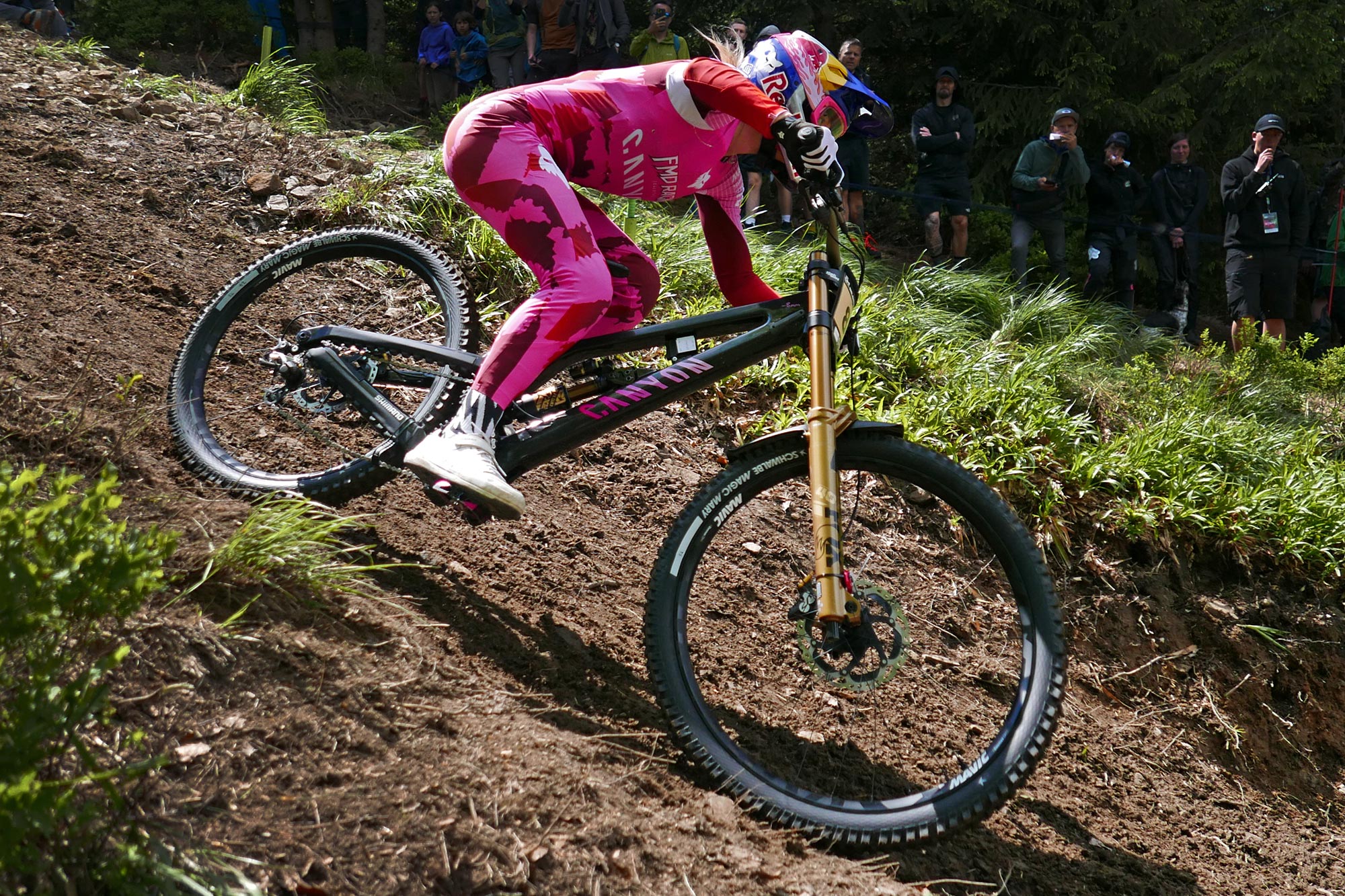A lot is going on with the next-gen Canyon Sender CFR prototype DH bike that we spotted Tahnee Seagrave and a couple of her Canyon CLLCTV teammates racing at the Bielsko-Biała World Cup over the weekend. First off, the unreleased carbon downhill bike features an all-new high single-pivot suspension design with an idler pulley that should manage chain tension. There’s a complex set of nested linkages to drive either air or coil shocks. And there are at least a couple of points to adjust geometry or suspension character. Plus, there’s the Canyon/Syntace KIS steering stabilizer system hidden inside the toptube.
Let’s take a closer look…
Unreleased Canyon Sender CFR prototype carbon DH bike

This new prototype carbon Canyon CFR DH bike is a complete departure from the current Sender CFR’s existing four-bar layout.
In the simplest of terms, it looks like this Sender prototype is an all-new high single-pivot suspension design for Canyon. From the rear axle, concentric with a rear pivot, that high swingarm mounts directly to the frame at the main pivot just above the idler pulley. Nope, that’s not just a seatstay.
There rear end gets much more complex when we look at what the left / non-driveside.

Here we can see that the lower swingarm is connected to a series of nested links that rotate around the bottom bracket. I’m not going to lose too much sleep over figuring this one out, and wait for a full explanation from Canyon when the new bike launches.
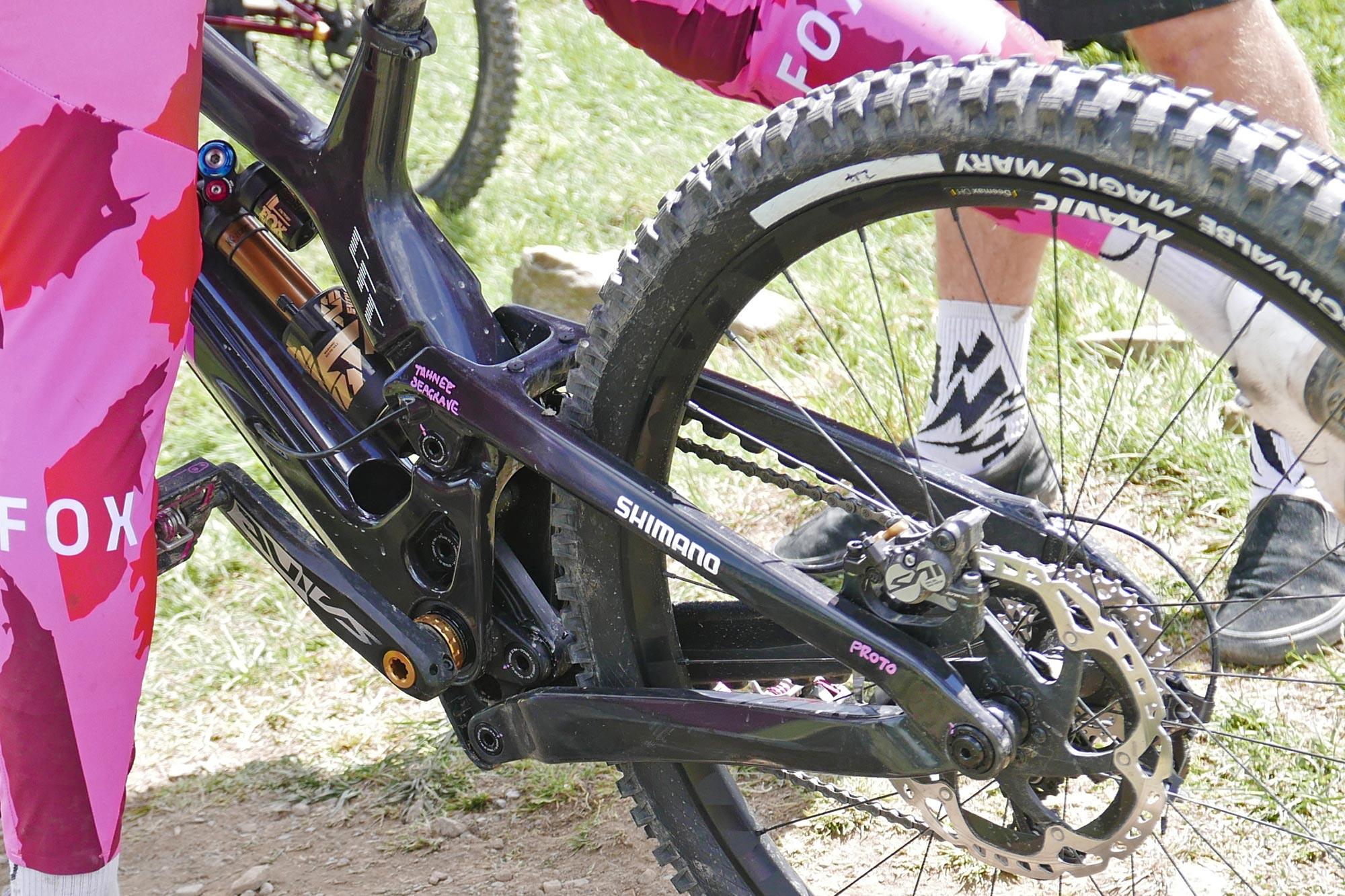
But what it looks like to me, is the following. The lower swingarm connects to a narrow control link that manages everything else. Rotation of that narrow control link moves around a pair of short links that pivot about the bottom bracket to move one final link that drives the shock. The shock link appears connected to the frame in front of the BB, to the control link visible in the window above the BB, then to a 90° extension of the shock just above that.
The whole complex mechanism seems to be just to be able to control how rear wheel travel is translated to shock stroke.
But why a high-pivot?
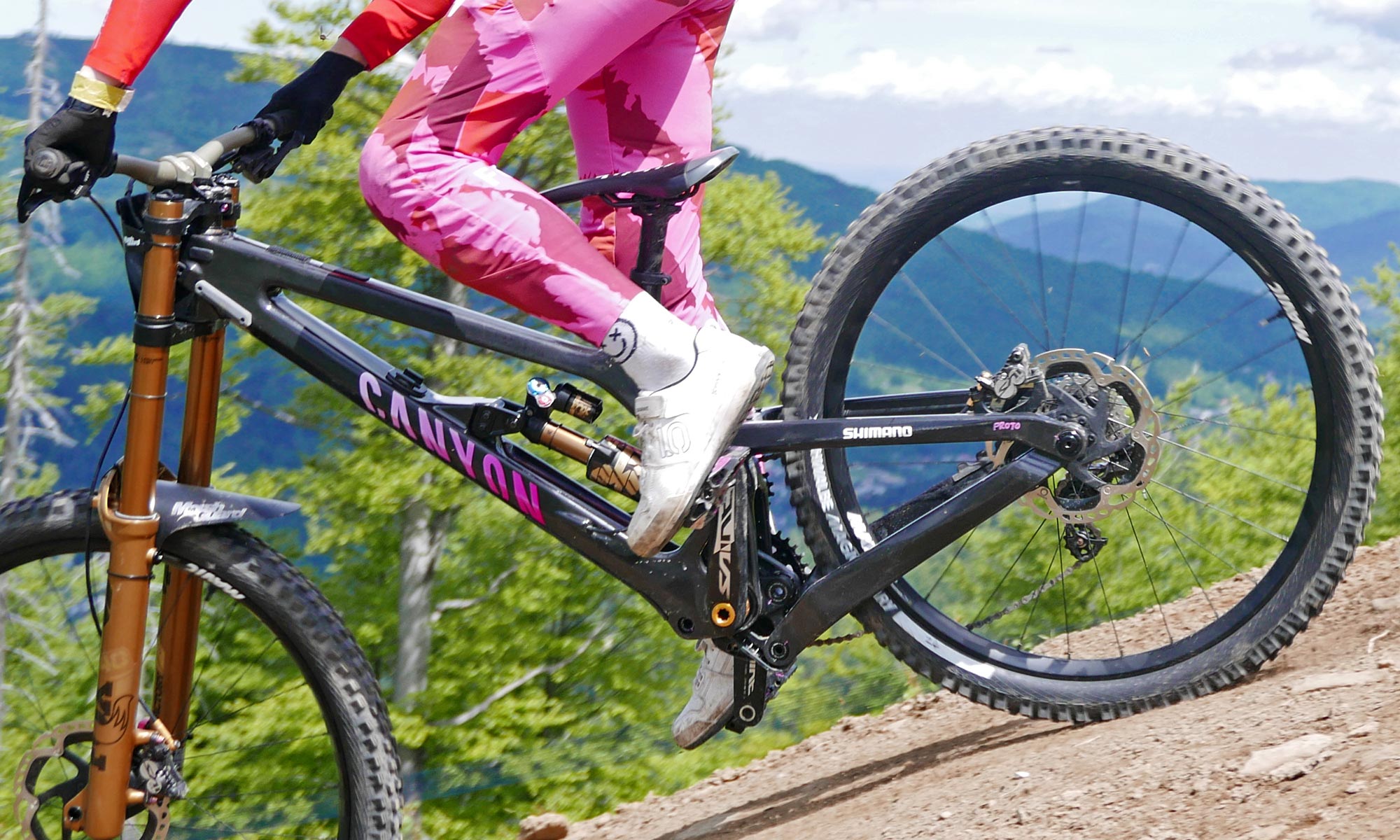
The high single-pivot design means a completely different rear axle path, initially moving back away from anything it hits, then up. The result is generally said to feel like more bottomless travel, that better rolls over square-edged obstacles, and helps racers maintain their momentum through rough sections of the racetrack.
It also means the bike’s chainstay length (distance from BB to rear axle) lengthens during compression. That’s helpful as the front center gets shorter when the telescoping fork compresses, so the lengthening rear end helps compensate, as the rider shifts their weight back on big compressions. And at the same time keeping the bike’s handling consistent, or even more stable as you encounter big hits.

The downside to the lengthening rear is generally chain growth and subsequent pedal kickback. But the idler pulley counteracts that. Most likely this bike will experience almost no pedal kickback. Probably one of the primary reasons Canyon went with this design for their DH race bike.
The idler layout essentially creates a parallelogram with the rear derailleur to eliminate chain growth through suspension compression. You do end up with less chain wrapped around the chainring, so chainguides become more important. That’s why this bike gets an upper guide in front of the idler and a lower chainring guide. Importantly, just behind the BB spindle.
Plus, an extra guide strapped on that lower stay can’t hurt for Seagrave. As we see in her start sprint (above, from the non-driveside), when she’s putting down max power through the pedals in the hardest/smallest cog, the frame hasn’t compressed much and her derailleur is struggling to keep the chain tight.
Adjustability & other setup details
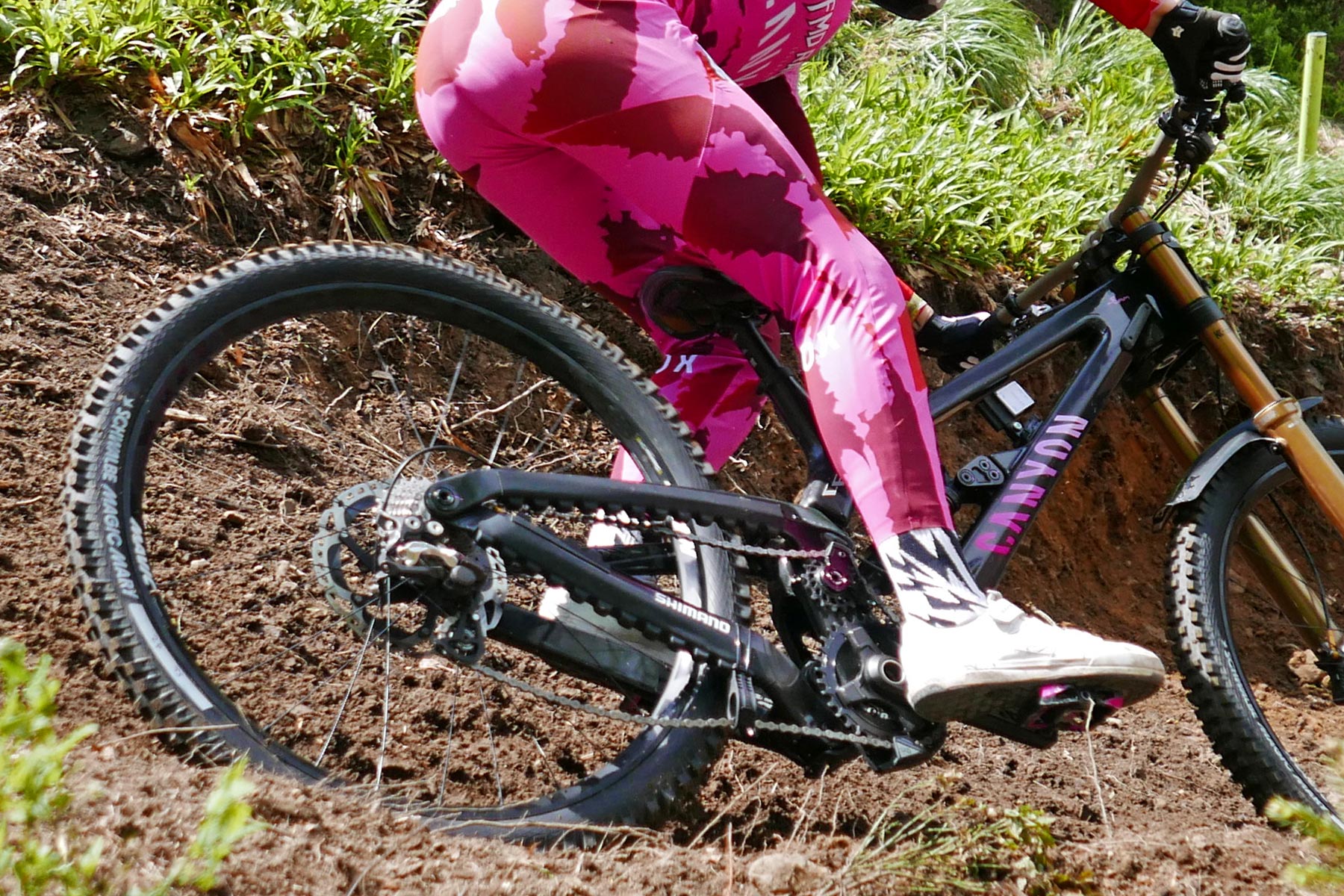
Beyond the seemingly complex configuration of the frame layout to drive the shock, we can also see some more bike adjustability between Seagrave & her CLLCTV teammates’ setup.
It appears (but I’m not 100% sure) that all three riding this Canyon Sender prototype have the bike set up as a mullet with a 27.5″ rear wheel. But there seems to be ample room between the tire and the swingarm bridges to fit a 29″ rear wheel in there, too. We suspect, somewhere in all of these frame linkages that a flip-chip will make either rear wheel size possible.
The frame definitely has adjustability to deliver different spring rates, with an adjustable upper shock mount. Tahnee Seagrave is riding with an up-turned black upper mount to match her Fox Float X2 Factory air shock. The two guys both have silver mounts turned down and paired to prototype RockShox BlackBox Vivid Coil (?) shocks with automatic Flight Attendant electronic controls.
The prototype Sender CFR also features a reach adjust headset – most likely angle adjust, as well. We know Seagrave’s racing a -8mm reach position, because here mechanics wrote it directly on the side of her headtube. Just like they used pink paint to mark that bolts throughout the bike are tight (and haven’t moved.)
What about the KIS steering stabilizer?

As we can see clearly in those photos (two above) illustrating why to opt for the high-pivot, Tahnee Seagrave is not actually using a KIS system. But her bike clearly has the blank filler plate that Canyon provides to buyers who decide to remove the factory-installed steering stabilizer.
I’ve personally ridden the Syntace & Canyon codeveloped KIS steering stabilizer system on several different bikes & ebikes over the last two years. And it’s super interesting. But it’s not for everyone. Once you adapt, it can really change how you ride. It especially gives extra confidence in loose turns and when dropping into rough tracks at high speed. But you have to relearn how to handle the bike at slower speeds, too.
It looks like Seagrave doesn’t see the benefit for her riding, at least not for now.
Canyon CLLCTV guys racing the new Sender prototype with KIS
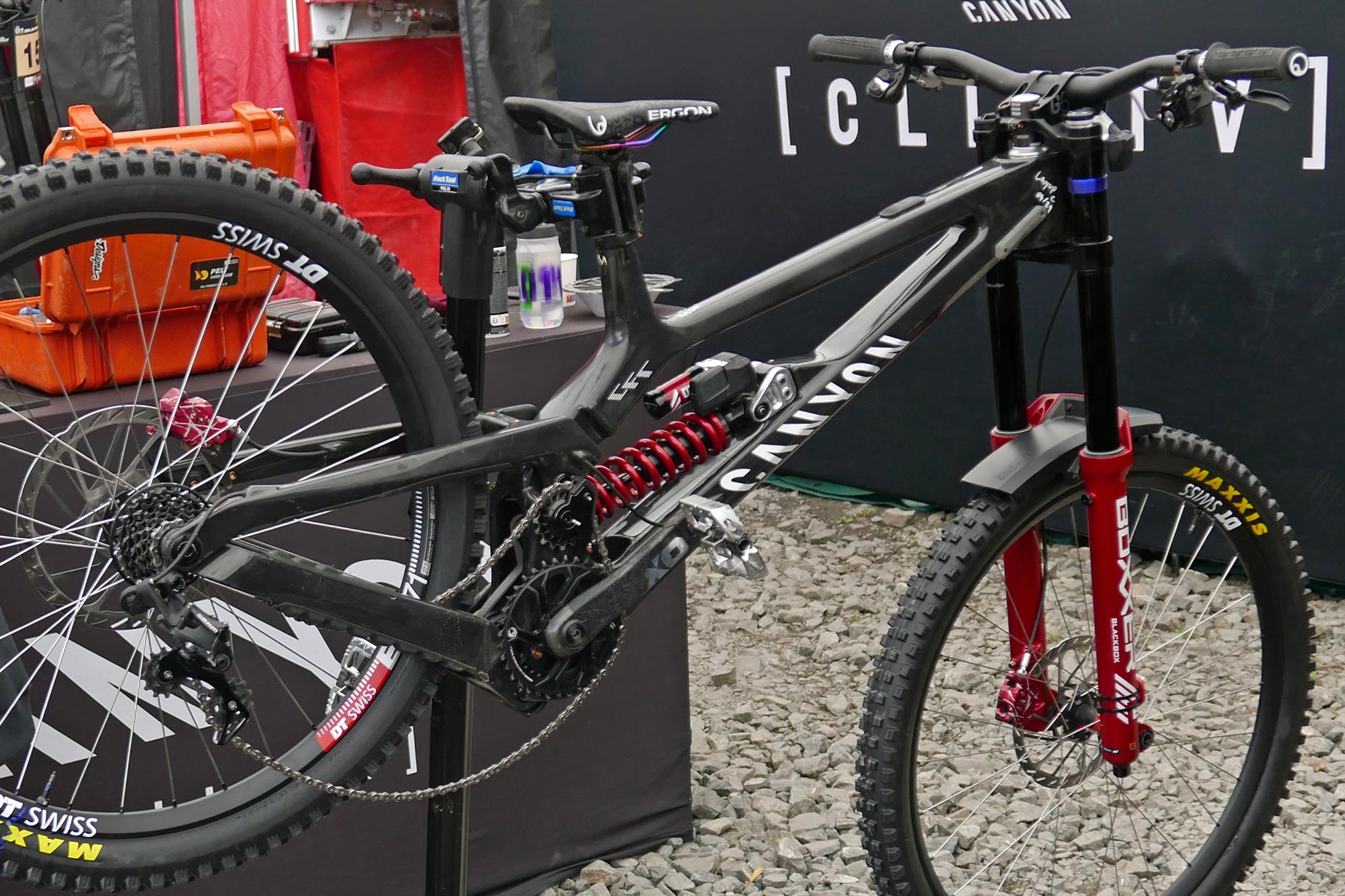
But, both Troy Brosnan & Luca Shaw are racing with the self-centering KIS spring system on their versions of the new prototype Canyon Sender CFR downhill bike. Canyon had previously told me that the CLLCTV team were testing out KIS. And now we can see that they are racing it on the World Cups, too.
The two guys are both racing with X01 DH groupsets vs. Seagrave’s Saint setup. Interestingly, Troy Brosnan is using the latest Maven Ultimate brakes that SRAM describes as their ‘most powerful ever‘. But Luca Shaw apparently prefers his long-trusted Code brakes still.
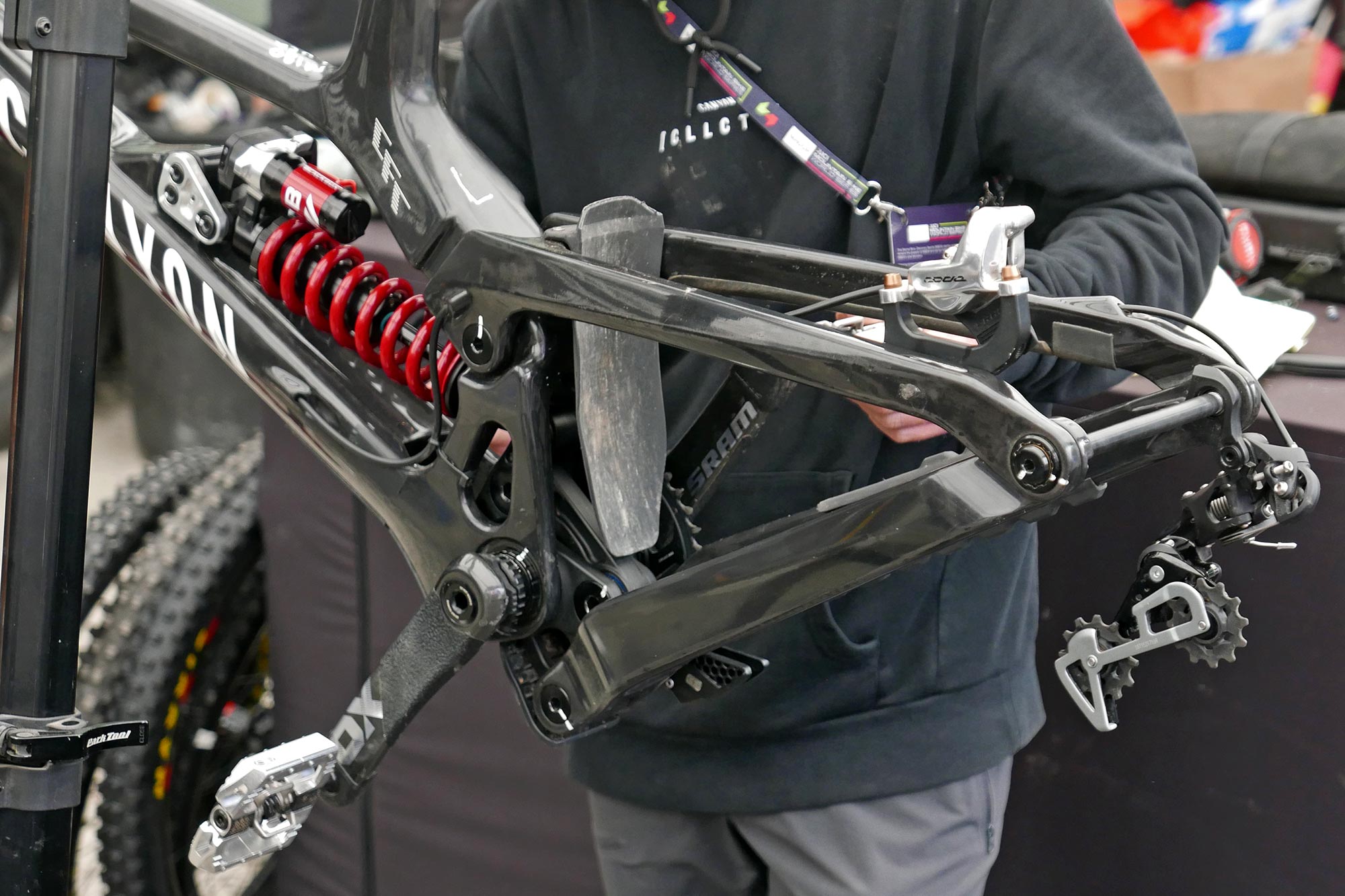
And they are both using the unreleased gravity tune of RockShox’s automated Flight Attendant suspension control system. Like on World Champ Vali Höll’s Tues, they both use the Quarq AXS transmitter on the driveside to send pedaling data. And without a DUB powermeter in their respective bottom brackets. And both have a left AXS shifter to override the automated modes, if needed.
We could see the two bolts on the swingarm bridge to mount a fender. And here, Luca Shaw’s bike has the mini fender installed to protect the complex linkage layout from mud spray.
Another curious suspension tweak, like Höll, Luca Shaw has the Flight Attendant control module on his RockShox BlackBoxxer fork turned out 90° sideways. But Troy Brosnan has his control module angled slightly forward (see the complete bike on the workstand, above). Perhaps, that is so he can either see the flashing light more clearly to be sure he’s in his preferred mode? Or even to hide the distracting flashing out of view under the bar?
Race-ready, but what about consumer-ready?

This is yet another prototype gravity that looks pretty well finished in carbon. So, it should come quickly to the market, right? Maybe not so fast.
Brosnan’s M-sized race bike has “Layup C” hand-written on the side of the headtube with a date from just last month, suggesting that even if the molds are done, Canyon are still dialing in the final material construction. Both Shaw & Seagrave’s bikes also have plenty of handwritten notes on them, too. My guess is this Canyon Sender prototype will continue to be tested for the full 2024 DH race season. Before it makes it into any consumer’s hands.
And lastly, Canyon still lists the current Sender CFR as ‘New’ on their website, with new builds in stock, and no carbon bikes currently on sale. I think it’s safe to say this is a MY25 DH bike. So, we’ll try to wait patiently until then.
